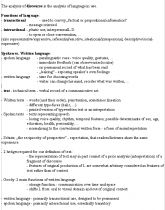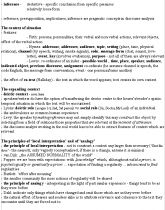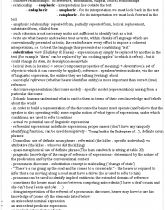Poznámky: G. Brown, G. Yule: Discourse Analysis
Skrýt detaily | Oblíbený- Kvalita:79,6 %
- Typ:Poznámky
- Univerzita:Univerzita Karlova v Praze
- Fakulta:Filozofická fakulta
- Kategorie:Jazyky
- Podkategorie:Angličtina
- Předmět:Text Analysis in Translation
- Autor:eliskabila
- Rozsah A4:10 strán
- Zobrazeno:1 672 x
- Stažené:0 x
- Velikost:0,1 MB
- Formát a přípona:MS Office Word (.doc)
- Jazyk:anglický
- ID projektu:2467
- Poslední úprava:06.12.2013
G. Brown, G. Yule: Discourse Analysis
© Cambridge University Press 1983
1. Introduction: linguistic forms and functions
The analysis of discourse is the analysis of language in use.
Functions of language:
- transactional - used to convey „factual or propositional information“
- message oriented
- interactional - phatic use, interpersonalL.D.
- to open or close conversation, ...
(also representative/expressive, referential/emotive, ideational/interpersonal, descriptive/social-expressive)
Spoken vs. Written language:
- spoken language - paralinguistic cues - voice quality, gestures, ...
- immediate feedback (can observe interlocutor)
- no permanent record of what has been said
- „leaking“ - exposing speaker’s own feelings
- written language - time for choosing words
- writer can change his mind, reorder what was written, ...
- text - technical term - verbal record of a communicative act
- Written texts - words (and their order), punctuation, sometimes lineation
- different type-faces (italic, ...)
- printed version of typewritten text is an interpretation
- Spoken texts - texts representing speech
- losing voice quality, rhythm, temporal features, possible determinants of sex, age, education, health, personality, ...
- normalising to the conventional written form - a form of misinterpretation
- Schutz: „the reciprocity of perspective“ - expectation, that readers/listeners share the same experience.
- 2 hedges required for our definition of text:
- the representation of text may in part consist of a prior analysis (interpretation) of a fragment of discourse.
- features of original production of L are somewhat arbitrary considered as features of text rather than of context
- Goody: 2 main functions of written language:
- storage function - communication over time and space
- shifts L from oral to visual domain and out of original context
© Cambridge University Press 1983
1. Introduction: linguistic forms and functions
The analysis of discourse is the analysis of language in use.
Functions of language:
- transactional - used to convey „factual or propositional information“
- message oriented
- interactional - phatic use, interpersonalL.D.
- to open or close conversation, ...
(also representative/expressive, referential/emotive, ideational/interpersonal, descriptive/social-expressive)
Spoken vs. Written language:
- spoken language - paralinguistic cues - voice quality, gestures, ...
- immediate feedback (can observe interlocutor)
- no permanent record of what has been said
- „leaking“ - exposing speaker’s own feelings
- written language - time for choosing words
- writer can change his mind, reorder what was written, ...
- text - technical term - verbal record of a communicative act
- Written texts - words (and their order), punctuation, sometimes lineation
- different type-faces (italic, ...)
- printed version of typewritten text is an interpretation
- Spoken texts - texts representing speech
- losing voice quality, rhythm, temporal features, possible determinants of sex, age, education, health, personality, ...
- normalising to the conventional written form - a form of misinterpretation
- Schutz: „the reciprocity of perspective“ - expectation, that readers/listeners share the same experience.
- 2 hedges required for our definition of text:
- the representation of text may in part consist of a prior analysis (interpretation) of a fragment of discourse.
- features of original production of L are somewhat arbitrary considered as features of text rather than of context
- Goody: 2 main functions of written language:
- storage function - communication over time and space
- shifts L from oral to visual domain and out of original context




